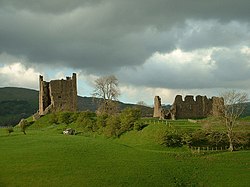Verterae
| Verterae | |
| Westmorland | |
|---|---|
 Part of the Roman earthworks, incorporated into a later castle | |
| Type: | Roman fort |
| Location | |
| Grid reference: | NY791140 |
| Location: | 54°31’17"N, 2°19’27"W |
| Village: | Brough |
| History | |
| Built 1st century AD | |
| Information | |
Verterae was a Roman fort whose earthworks are found today in the village of Brough in Westmorland. Occupied between the 1st and 5th centuries AD, Verterae protected a key Roman road in the north of Roman Britannia.
In the 11th century, Brough Castle was built on part of the site by the Normans. Archaeologists explored the remains during the 20th century and it is now a scheduled ancient monument.
Roman period
Verterae was probably built by the Roman governor Gnaeus Julius Agricola between AD 79-80, as part of his campaign to conquer the north of Britain.[1] The name meant "the Forts", and it served as a waypoint on the northern leg of the Roman-era road connecting the Roman towns of Luguualium (Carlisle) with Eboracum (York), and points further south.[2][3]
One of a sequence of forts that lay every 12 miles to 14 miles along the route, the site protected the Stainmore Pass that stretched from the River Eden across the Pennines.[4][3]
The rectangular fort was 3 acres in size, constructed on a ridge overlooking the Swindale Beck.[5][6] The size of the fort is uncertain, due to later work on the site, but it may have been approximately 100 yards across east to west, with a ditch up to 50 feet wide and 20 feet deep in places.[6] A settlement called a vicus and cemetery was constructed on the east side of the fort.[6] The vicus included both stone and wattle-and-daub buildings.[6]
Around the time of the late 4th century and early 5th century, an Auxiliary unit called the Numerus Directorum, around 300-400 strong, were based in the fort.[6]
The site is not far from Maiden Castle.[7] Old gazetteers claim this gave a name to the Maiden Way, the old Roman road from nearby Bravoniacum (Kirkby Thore) to Magnae Carvetiorum (Carvoran) on Hadrian's Wall.[8]
Post-Roman period
The fort was occupied for a time after the Roman withdrawal around the year 410 but was eventually abandoned.[9] In the 11th century, a Norman castle was built within the ruined walls of the fort. In the 16th century the antiquarian William Camden rediscovered the link between the location and the Roman occupation, arguing that this site, by then called Brough, was the Roman fort of Verterae.[1]
Rubbish from the Roman period was discovered on the site in the mid-19th century, and archaeological excavations were carried out in 1923 by the government.[6] More excavations followed in 1954 and during the 1970s and 1990s, with a comprehensive survey of the site being conducted in 1996.[6] The area of the fort, covering the mediæval castle, Brough Castle Farm and the surrounding lands, is protected under law as a Scheduled Ancient Monument.[6]
See also
References
- ↑ 1.0 1.1 "The Roman Fort of Verteris". English Heritage. http://www.english-heritage.org.uk/daysout/properties/brough-castle/port-history-and-research/history/1-roman-verteris/. Retrieved 19 February 2015none
- ↑ Gordon 1949, p. 152
- ↑ 3.0 3.1 Brough Castle: History and research
- ↑ Noakes 2008, p. 4; Pettifer 2002, p. 266
- ↑ Gaskill, Noakes & Woods 2009, p. 4
- ↑ 6.0 6.1 6.2 6.3 6.4 6.5 6.6 6.7 National Heritage List 1007148: Maiden Castle
- ↑ National Monuments Record: No. 15918 – Maiden Castle Roman Fortlet
- ↑ "Roxburghshire". The Topographical, Statistical, and Historical Gazetteer of Scotland. II. Edinburgh: A. Fullarton & Co.. 1853. https://books.google.co.uk/books?id=sIHRAAAAMAAJ&pg=PA624.
- ↑ Gaskill, Noakes & Woods 2009, p. 4
- Gaskill, Nicola; Noakes, Helen; Woods, Frances (2009). An Archaeological Watching Brief and Investigation at Brough Castle, Church Brough. Alston, UK: North Pennines Archaeology. http://archaeologydataservice.ac.uk/catalogue/adsdata/arch-704-1/dissemination/pdf/northpen3-61730_1.pdf.
- Gordon, Seton (1949). Highways and Byways in the Central Highlands. London, UK: Macmillan & Co.. http://tera-3.ul.cs.cmu.edu/NASD/d23d381a-642a-4cb1-bd42-5373f518ed1d/lemur/6516.sgml.
- Noakes, Helen (2008). An Archaeological Field Evaluation at Brough Castle, Church Brough. Alston, UK: North Pennines Archaeology. http://archaeologydataservice.ac.uk/catalogue/adsdata/arch-704-1/dissemination/pdf/northpen3-48396_2.pdf.
- Pettifer, Adrian (2002). English Castles: A Guide by Counties. Woodbridge, UK: Boydell Press. ISBN 9780851157825. http://books.google.co.uk/books?id=47iheRUGKIEC.